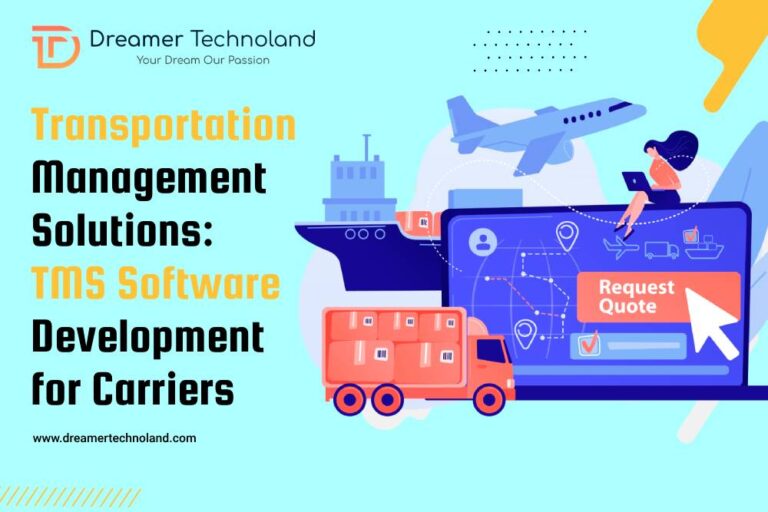
Contents
Building a Transportation Management System (TMS) involves several crucial phases. You need to ensure perfection in each step for the smooth functioning of the custom TMS software. In this blog, we will walk you through a roadmap to guide you through the process:
- Define Your Target Market and NeedsIdentify your niche: Will the transportation management system development cater to specific industries (e.g., logistics, retail) or offer general functionalities? Understand user needs: Research the pain points of your target audience (shippers, carriers, brokers). What challenges do they face in transportation management?
- Feature Planning and Prioritization:
- Core functionalities: Prioritize essential features like shipment management, route optimization, carrier selection, and real-time tracking with custom transportation management application development.
- Advanced features: Consider offering additional features like freight cost management, document management, analytics, and integration capabilities.
- Technology Stack Selection:
- Programming Languages: Popular choices include Python, Java, and JavaScript for their versatility and scalability.
- Cloud Storage: Cloud storage platforms (e.g., Amazon S3, Microsoft Azure) offer scalability and reliability for data storage for fleet management app development.
- Front-end Development: Frameworks like React or Angular can streamline user interface (UI) development for a user-friendly experience.
- Back-end Development: Django, Ruby on Rails, or Node.js are commonly used for server-side functionalities and database management.
- Development Process
- System Design: Design a system architecture that can handle data flow, user access controls, and ensure security.
- Security Implementation: Prioritize robust security measures to protect user data, financial information, and shipment details in the best TMS software for carriers.
- API Integration: Integrate with external services like mapping APIs, carrier databases, and e-commerce platforms (if applicable).
- Testing and Deployment
- Rigorous Testing: Thoroughly test all functionalities to identify and fix bugs before deployment. Ensure the custom TMS software performs well under load.
- Deployment Options: Choose between a cloud-based TMS (SaaS) or an on-premise solution depending on your scalability needs and security considerations.
- Maintenance and Updates:
- Regular Updates: Continuously update your logistics software development company with new features, bug fixes, and security patches to stay competitive and address user feedback.
- Technical Support: Provide ongoing technical support to your TMS users to address any issues or answer questions they may encounter.
Additional Considerations
- Mobile Compatibility: In today’s mobile-first world, optimize your TMS for seamless use on smartphones and tablets.
- Compliance: Ensure your transportation management system development adheres to relevant data privacy regulations and industry standards depending on your target market.
- Data Analytics: Integrate data analytics tools to provide users with insights into transportation performance, identify cost-saving opportunities, and make data-driven decisions.
Significance of a Transportation Management System
In today’s globalized world, efficient and cost-effective transportation is vital for businesses of all sizes. A custom transportation management application development company goes beyond simply managing shipments; it’s a powerful tool that optimizes logistics operations, enhances visibility, and streamlines the entire transportation process. Here’s why a TMS is significant for businesses:
Enhanced Efficiency and Cost Savings
- Route Optimization: Custom TMS software identifies the most efficient routes for deliveries, considering factors like distance, traffic patterns, and fuel costs. This reduces transportation time and fuel consumption, leading to significant cost savings.
- Carrier Management: Custom TMS software facilitates streamlined carrier selection based on pricing, reliability, and specific shipment requirements. You can compare rates from different carriers and negotiate better deals.
- Automated Processes: TMS automates repetitive tasks like shipment booking, document generation, and invoice processing, freeing up staff time for more strategic activities.
Improved Visibility and Control
- Real-time Tracking: Track the location and status of your shipments in real-time, providing greater transparency throughout the transportation process.
- Proactive Exception Management: Identify potential delays or disruptions early on and take corrective actions to minimize their impact using fleet management app development.
- Inventory Management: TMS integrates with inventory management systems, providing better visibility into stock levels and ensuring on-time deliveries to meet customer demands.
Increased Customer Satisfaction
- Accurate Delivery Times: Improved route planning and real-time tracking enable you to provide accurate estimated delivery times to customers, enhancing their overall experience.
- Improved Communication: Best TMS software for carriers facilitates clear communication with customers regarding shipment status and any potential delays.
- Reduced Order Fulfillment Errors: Streamlined processes and improved visibility minimize errors in order fulfillment, leading to higher customer satisfaction.
Summary
Building a TMS from scratch is a complex endeavor that requires significant resources and expertise. An alternative approach for businesses with less complex needs is to consider utilizing existing, cloud-based TMS solutions offered by various software vendors. These solutions are often readily available with subscription-based pricing models. Get in touch with experts of Dreamer Technoland for more information about transportation management system development.